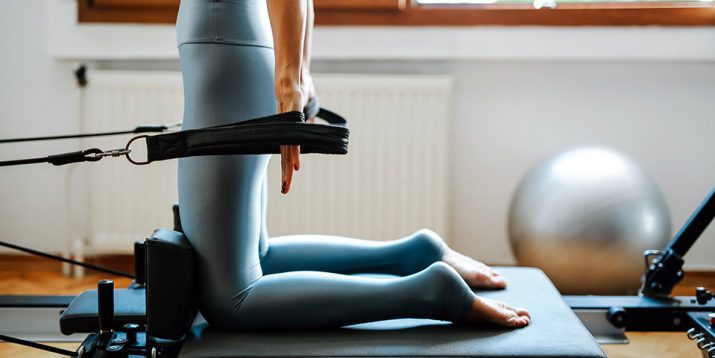Everything You Wanted to Know About Pilates

Scroll through social media and it won’t take long to find a photo of someone stretching their toned muscles on a Pilates reformer, raving about their most recent Pilates workout.
It seems like everyone who swears by Pilates has the impressive flexibility and crazy-strong core to show for it — so you may be wondering if you should give Pilates a try, too.
But what kind of workout is Pilates, exactly?
What’s the difference between Pilates and yoga? And should you add Pilates to your exercise regimen to help you lose weight?
Here’s what you need to know.
What Is Pilates?
“Pilates is a series of movements on the mat that incorporate the whole body. With every single exercise, there’s core engagement. When you find that, you are doing Pilates!” says Andrea Rogers, creator of Xtend Barre and XB Pilates.
Every Pilates move is designed to strengthen the “powerhouse” of the body, a.k.a. the core.
Pilates dates back to the early 1900s. Its creator, Joseph Pilates, struggled with illness as a child and developed a series of exercises to build strength.
Later, he used these exercises while interned during World War I to help his fellow inmates maintain their health.
And while modern-day Pilates workouts may incorporate the use of props and machines, many exercises — like leg kicks and clamshells — have stayed the same for the past 100 years.
What Are the Benefits of Pilates?
- Stronger Core Muscles: When we hear the word “core,” many of us think of our abs (and that coveted six-pack). But the core is actually a network of muscles that starts at your pelvis and continues to the base of your neck. Your core includes the internal and external obliques, the traverse abdominis, and the multifidus and erector spinae, Erven says. Developing a strong core can help improve your posture and give you a longer, leaner look.
- Increased Flexibility: Feeling a little tight when you bend over to tie your shoelaces? Pilates can help improve flexibility. That’s because the slow, controlled movements allow muscles to stretch further, improving range of motion over time, Erven says.
- Better Muscle Endurance: One study found that two one-hour Pilates sessions per week, for 12 weeks, were enough to improve abdominal endurance and upper-body endurance.
- A Beginner-Friendly Workout: Pilates may seem intimidating if you’ve never tried it, but it’s actually perfect for beginners. Pilates moves are challenging, but they can be modified for all fitness levels, which means everyone — from total beginners to athletes — can experience the benefits of Pilates. “The movements can be adapted for all types of bodies and all ages. A class can be taught with modifications for ages teens – seniors,” says Andrea.
Pilates vs. Yoga: What’s the Difference?
The focus on flexibility and core strength might remind you of yoga, but there are a few key differences between yoga and Pilates.
“Yoga has a history of practicing meditation with vinyasa movement,” Andrea says, which aims to center the mind and body.
Pilates, on the other hand, tends to be more fitness-focused.
“Pilates is a modern-day movement modality focused on achieving physical goals and increasing core strength,” she says.
There Are Two Types of Pilates
While most Pilates workouts like XB Pilates are centered around the same moves, there are two main formats you can try to find the right workout for you.
1. Mat Pilates
Mat Pilates is often the most recognizable and accessible form of Pilates because it can be done almost anywhere, as long as you have a mat.
“It features foundational core work executed with precision and focus,” Andrea says. “Additional props [like balls, resistance bands, and weights] can be included to intensify your experience.”
2. Reformer Pilates
In Reformer Pilates, a machine called — you guessed it — the Reformer makes the workout more challenging.
Using spring resistance and a moving carriage, the Reformer provides an unsteady surface that challenges your balance when you stand or kneel on it.
Can Pilates Help You Lose Weight?
Pilates might be able to help you lose weight, but there are a lot of factors that play into the fat-burning power of the workout.
“It depends what kind of Pilates you’re doing,” Erven says.
A slow Pilates workout won’t have the same calorie-torching ability of a fast-paced class designed to work up a sweat.
“High-intensity Pilates that burns 300 to 500 calories a workout can assist anyone with weight loss if they’re committed to a solid nutrition plan,” Erven says.
So if weight loss is your main goal, look for a higher-intensity Pilates workout — and be sure to keep your nutrition in check.
What Should I Wear to Pilates?
The best things to wear to Pilates are clothes that are comfy, functional, and form-fitting. Your wardrobe include:
- Form-fitting tops
- Leggings
- A supportive sports bra
- Grip socks



